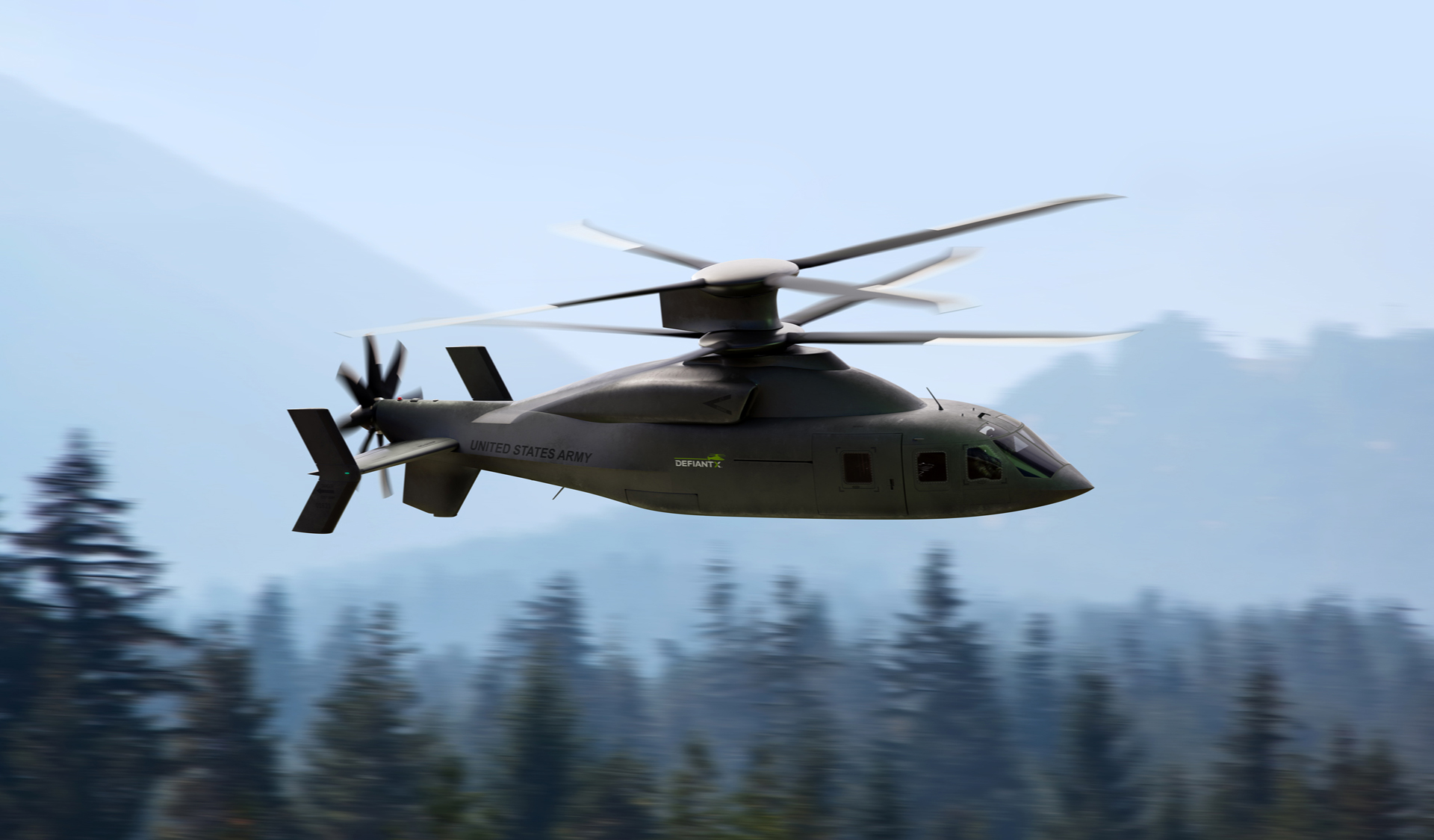Sikorsky-Boeing and Bell have formally entered the US Army’s Future Long-Range Assault Aircraft (FLRAA) program that aims to replace the UH-60 Black Hawk helicopter.
Lightning Aircraft Carriers, ‘Super’ Fighter Jets; US Mulls Complete Change In Strategy To Counter China
Sikorsky-Boeing’s Defiant X, a contra-rotor (or coaxial rotor) helicopter, and Bell’s V-280 tilt-rotor, both technology demonstrators (TD) were extensively tested, data from which have been included in their proposal to the FLRAA.
The US Army aims to field the first example of the utility craft not later than 2030, following a Production Contract (PC) expected to be issued in 2022. Both prototypes first participated and were rigorously tested as a part of the US Army’s Joint Multirole Technology Demonstrator (JMR-TD) project. The companies’ final pitches are expected to be improved based upon the lessons learned from the exhaustive JMR-TD testing.

According to the FLRAA procurement, the US Army wants the next-generation rotorcraft to have a maximum cruise speed of 519 km per hour, an unrefuelled combat radius of 556 km, and a one-way unrefuelled range of at least 2,440 km.
The Defiant X was based on the earlier SB-1 prototype, which did not fly until mid-2019 due to issues with its composite rotor-blade manufacturing process and transmission gears.
Defiant X
The more refined Defiant X differs from the SB-1 in its exhaust outlets that are covered by a shroud to reduce their infrared signature (to avoid infrared homing missiles); a nose wheel in addition to two mid-section wheels and a small wheel under the tail; a pointier nose cone for smoother aerodynamic flow and lower drag, and; a V-shape trailing edge in place of a straight one.
If inducted, the Defiant X would become the first contra-rotor configuration helicopter in the US military, with Russia being the first to use such rotary-wing aircraft – the Kamov Ka-50/52 attack helicopters and the Ka-31/27 naval helicopters.
Developed By Israel, Designed For Asia – Meet ‘Re-Engineered’ Kfir Fighter Jet That Resembles The Mirage 2000
“Defiant X delivers speed where it matters, survivability, unsurpassed power, maneuverability, superior handling in any environment and lower lifecycle costs – while operating in the same footprint as the Sikorsky UH-60 Black Hawk,” said a joint statement from Mark Cherry, Vice-President and General Manager of Boeing and Paul Lemmo, President of Sikorsky.

Interestingly, the statement ended with naming the political, geopolitical, and doctrinal exigencies influencing the FLRAA program when it said it was the Indo Pacific Command (INDOPACOM) as the theatre for which the Defiant X is being pitched. “We are confident that DEFIANT X, supported by our longstanding Army industrial base suppliers, is the best choice for delivering overmatch on the Multi-Domain Operational battlefield in INDOPACOM and across the globe,” the statement said.
Focus On Indo-Pacific
Multi-Domain Operational concept is a new doctrine being developed by the US military to the emergent high-technology and the “informationized warfare” challenge being posed by the Chinese military in Far East Asia, as the US sees a return to a new “Great Power” contest.
Bell’s V-280 is no less an interesting machine itself, as it continues the revolutionary tilt-rotor legacy, where huge propellers on the wingtips turn on a full 2D upward and forward axis. The former allows the aircraft to take off and hover like a helicopter and after attaining the desired altitude, the forward position pushes the air-thrust backward to propel it forward like a plane.
SB>1 DEFIANT — the tech demonstrator for #DEFIANTX — just lifted 5,300 lbs. in flight test! That’s equivalent to an Infantry Squad Vehicle or hundreds of thousands of rounds of ammunition — vital equipment and supplies Soldiers need during combat. #FLRAA@Sikorsky ? Boeing pic.twitter.com/ZBZV2V3Sm4
— Boeing Defense (@BoeingDefense) July 22, 2021
Its predecessor is the V-22 Osprey that operates from US Navy’s helicopter carriers and Landing Platform Docks (LPD), used to rapidly insert troops into war zones. The Osprey was apparently a Bell and a Boeing product, with both companies now being competitors for the FLRAA procurement.
The V-280 retired and was finally grounded in June this year, after a three-and-a-half-year testing program with the JMR-TD project, after first flying in December 2017. It flew more than 214 hours at the hands of five US Army experimental test pilots in more than 15 sorties, demonstrating low-speed agility, long-range cruise capabilities, and touching a maximum speed of 305 knots – higher than the FLRAA requirement of a 230 to the 250-knot range.
The future long-range air assault mission is about delivering troops and equipment to exactly where they are needed, fast. #DEFIANTX is the right fit for the @USArmy.@Sikorsky ? @BoeingDefense #FLRAA #ArmyModernization pic.twitter.com/6L2CYBjwqp
— Sikorsky (@Sikorsky) September 9, 2021
Feedback gathered from the pilots, infantry squads and ground/maintenance crew will inform its final product and design for the FLRAA program.
The V-280 is different from the V-22, in that it has tilting ‘nacelles’ in place of full tilting engines that put more stress on the airframe and caused maintenance issues. However, Bell remains firmly convinced of the tilt-rotor approach for the FLRAA requirement.
“The FLRAA challenge presented by the US Army was unattainable using helicopter configurations. They have been clear about the need to modernize and field transformational capabilities. We assessed several vertical lift technologies and determined the tilt-rotor to be the only solution to the agility, range, and speed requirements of a Long-Range Assault Aircraft that can meet the cost, timeline, and risk profile required for a successful acquisition program,” Keith Flail, executive vice president for advanced vertical lift systems at Bell, said in a statement.
- Parth Satam is a Mumbai-based journalist who has been covering India’s defense sector for more than a decade. He maintains a keen interest in defense, aerospace and foreign affairs and can be reached at satamp@gmail.com
- Follow EurAsian Times on Google News




